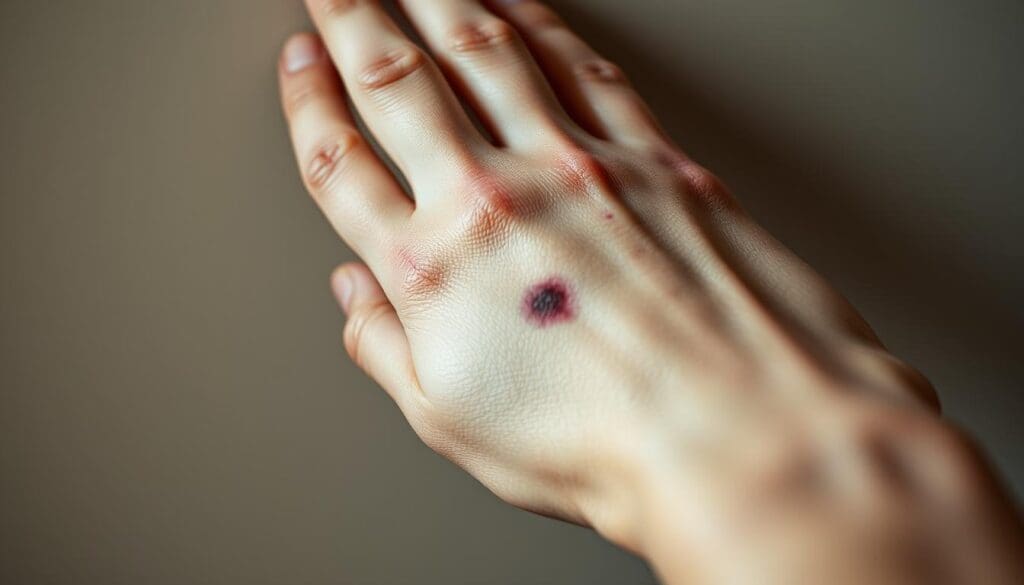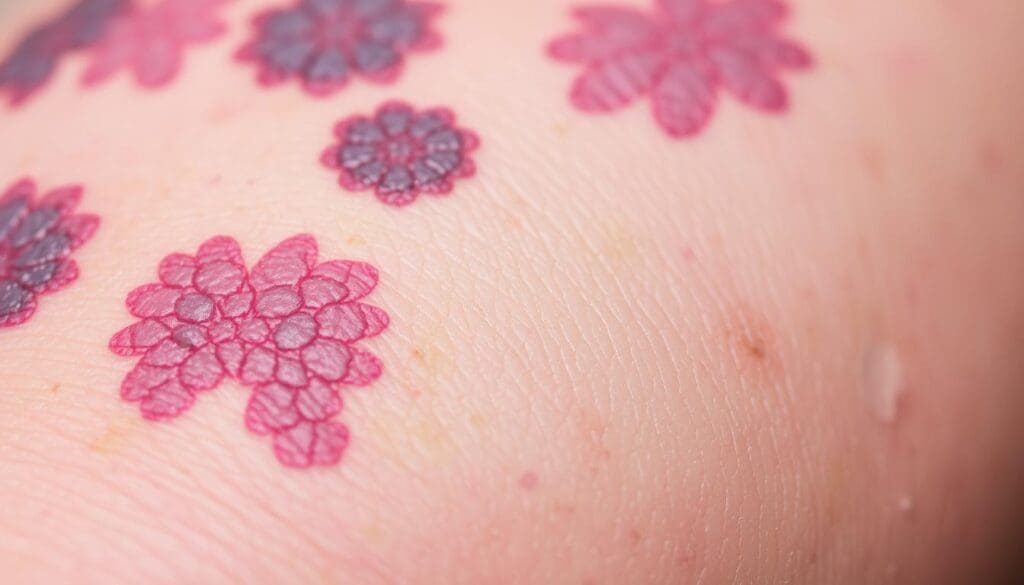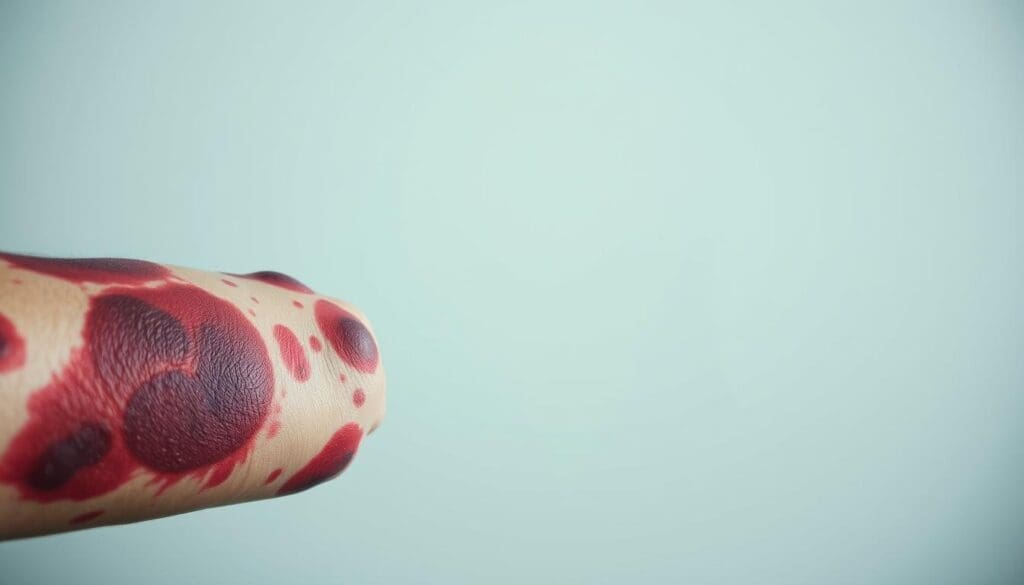Last Updated on November 20, 2025 by Ugurkan Demir

What cancer causes bruising is a common question people ask when they notice unexplained marks on their skin. At Liv Hospital, we understand that sudden or easy bruising can be worrying. One possible cause is leukemia, a cancer of the blood-forming tissues that often leads to bruising or bleeding.
Leukemia affects the white blood cells and interferes with the body’s ability to make platelets. Since platelets help the blood to clot, low platelet counts can cause easy or unexplained bruising. If you notice frequent bruises without any clear reason, it’s important to see a doctor and understand what might be happening inside your body.

Cancer can make bruising more common in some patients. Bruising is a symptom seen in many health issues, including cancer and bruising. This is a big worry for many.
Normal bruising happens when blood vessels get damaged. This lets blood leak into the tissue around it. The body tries to stop the bleeding and fix the vessels.
But, cancer can mess with this process. It can make it harder for blood to clot.
Cancer can cause bruising by messing with blood clotting. This is often because of low platelet counts or bad platelets. For example, leukemia can lower platelet production. This makes it harder for blood to clot right.
This leads to easier and more severe bruising.
Bruising is common in cancer patients, but more so in those with blood cancers like leukemia. How often bruising happens can depend on the cancer type and stage. Knowing how bruising as a sign of cancer relates to the cancer type is key for early detection and treatment.
By understanding cancer-related bruising, patients and doctors can spot signs of cancer sooner. This can lead to earlier diagnosis and better treatment.

Some cancers are more likely to cause bruising because they affect blood clotting. Bruising is a common issue for many cancer patients. Knowing the causes can help manage this symptom better.
Leukemia is a top cancer linked to bruising. It affects the blood and bone marrow, making it hard to produce platelets. Platelets are key for blood to clot.
Leukemia’s effect on platelet production is a big reason for bruising in patients. The disease makes it hard for the bone marrow to make enough platelets. This leads to a condition called thrombocytopenia.
Other blood-related cancers like lymphoma and myeloma can also cause bruising. These cancers affect different parts of the blood and immune system. This can lead to bruising and bleeding problems.
Lymphoma can cause bruising by affecting the lymphatic system. Myeloma affects plasma cells in the bone marrow. This can lead to bone damage and other issues, including bruising.
Advanced cancers can also cause bruising. As cancer grows, it can spread to areas important for blood clotting. This disrupts the clotting process and leads to bruising.
Also, treatments for advanced cancer, like chemotherapy and radiation, can affect blood clotting. This increases the risk of bruising.
It’s important to know how leukemia affects platelets. Leukemia is a cancer that harms the blood and bone marrow. It can lower platelet production, causing many problems.
Platelets are key in stopping bleeding and bruising. They clump together to form clots when we get hurt. A healthy person has 150,000 to 450,000 platelets per microliter of blood. Platelets are vital for stopping bleeding from small injuries.
Leukemia harms the bone marrow’s platelet-making ability. Leukemia cells fill the bone marrow, pushing out normal cells. This leads to thrombocytopenia, or low platelet counts.
Thrombocytopenia makes bruising more likely. With fewer platelets, even small injuries can cause big bruises. The more severe the thrombocytopenia, the worse the bruising.
| Platelet Count (per microliter) | Bruising Risk Level |
| 150,000 – 450,000 | Normal |
| 50,000 – 149,000 | Mild |
| 20,000 – 49,000 | Moderate |
| < 20,000 | Severe |
Knowing how leukemia affects platelets is key to managing the disease. Recognizing low platelet counts is important. It helps patients get help quickly to avoid bleeding and bruising risks.
It’s important to know the different bruising patterns linked to leukemia. This knowledge helps in early detection and treatment. Leukemia can cause various types of bruising, so it’s key to spot these signs to tell them apart from regular bruises.
Petechiae are small, circular bruises that look like tiny spots on the skin. They often appear in groups and can show up without any injury.
Leukemia is also linked to perfect round bruises. These bruises are the same size and shape, unlike regular bruises which are irregular.
Leukemia patients may also see larger bruise patches. These are big areas of bruising that don’t seem to be caused by any injury.
A big worry with leukemia bruising is that it can happen without any apparent trauma. This is concerning because it might mean there’s a problem with blood clotting or platelet production.
| Bruise Type | Description | Characteristics |
| Petechiae | Small, circular bruises | Pinpoint spots, often in clusters |
| Perfect Round Bruises | Uniform, round bruises | Typically uniform in shape and size |
| Larger Bruise Patches | Extensive areas of bruising | May not be related to specific injury |
The location of bruises on the body can hint at cancer, like leukemia. Bruises from leukemia and other cancers show up in different body parts.
Leukemia bruises often pop up on arms and legs. This happens because the body can’t make enough platelets. Platelets help blood clot, so low counts mean even small injuries can cause big bruises.
Bruises on the back and spine can also point to leukemia. These bruises are more obvious in people with advanced leukemia or those getting chemotherapy. They can be small spots or big patches.
In cancer’s early stages, bruises can show up anywhere, often without a clear reason. For leukemia, common spots include arms, legs, back, and spine. Watching for unusual bruising is key, as catching it early can greatly improve treatment chances.
| Location | Common Characteristics |
| Arms and Legs | Often appear as larger bruises or patches, may be accompanied by petechiae (small red or purple spots) |
| Back and Spine | Can range from small to large bruises, may be more noticeable in advanced stages or during treatment |
| General | Bruising without trauma, frequent or recurring bruising |
It’s important for patients and doctors to know about cancer bruises. Bruises can happen for many reasons, but some signs point to cancer.
Cancer bruises look different. They might be small, circular bruises called petechiae, or bigger patches. Their color change is also unique. Unlike regular bruises, cancer bruises often stay consistently discolored.
Cancer bruises take longer to heal. Most bruises go away in a couple of weeks. But, cancer bruises can take longer than two weeks to heal. This slow healing is a warning sign.
Cancer bruises can hurt or feel tender. This is different from regular bruises, which usually don’t hurt. If you feel pain or tenderness, talk to a doctor.
Cancer bruises also come with other symptoms. These include fatigue, weight loss, or fever. If you notice these symptoms with bruises, see a doctor right away.
Knowing how to spot cancer bruises helps people understand their health better. If you’re worried about bruises or other symptoms, talk to a healthcare professional.
Easy bruising can be caused by many things, not just cancer. Certain medicines and aging can also play a role. Knowing these causes helps figure out if your bruising is serious or not.
Some medicines can make you bruise more easily. These include:
A study in the Journal of Clinical and Aesthetic Dermatology found a link between anticoagulant therapy and bruising. If you’re on these medicines, talk to your doctor about your bruises.
| Medication Type | Effect on Bruising |
| Anticoagulants | Prevent blood clotting, increasing bruising risk |
| Antiplatelet drugs | Prevent platelet clumping, leading to easier bruising |
| NSAIDs | Affect platelet function, potentially increasing bruising |
| Corticosteroids | Can cause skin thinning, making it more prone to bruising |
As we get older, our skin changes. It gets thinner and the blood vessels get weaker. This makes it easier to bruise, even from small bumps.
Some blood disorders can also cause easy bruising. These include:
These conditions make it hard for the body to stop bleeding. This can lead to prolonged bleeding or bruising.
Easy bruising can often be caused by things other than cancer. If you have frequent nosebleeds, bleeding gums, or bleeding that won’t stop, it might be a blood disorder. Aging and certain medicines are also common reasons. But, if you’re worried about your bruises, see a doctor to check for serious problems.
Bruising is common, but some signs can mean something serious like cancer. We must know the warning signs for cancer-related bruising.
Frequent bruising without reason or trauma is a red flag. Multiple bruises in different healing stages suggest blood clotting or platelet issues. These can be linked to cancers like leukemia.
Significant bruising from minor bumps or scrapes is a problem. It shows the body can’t clot blood right. This is not normal and needs checking.
Bruising in places like the torso, back, or face without reason is a concern. Cancer can cause this due to its effect on blood vessels and clotting.
Bruises that last too long or don’t heal as they should might be cancer-related. Normally, bruises change color and heal in two weeks. If a bruise stays the same or gets bigger, see a doctor.
Watching for these red flags can help find cancer early. If you see any of these signs, talk to a healthcare professional.
Bruising can be a worrying sign, even more so if it might be linked to cancer. Knowing how cancer and bruising are connected is key to catching it early. If you see unusual or lasting bruises, it’s best to talk to a doctor.
Being alert to signs of serious conditions is important. We’ve talked about how to spot bruises linked to leukemia and cancer. If you think your bruises might be cancer-related, get medical help right away.
Being proactive about your health is vital. If you notice unusual bruising, don’t ignore it. See a doctor to figure out what’s going on and how to fix it.
Easy bruising can sometimes mean cancer, like leukemia. This is because cancer can mess up blood cell making, causing bruises. But, it’s not just cancer. Other things can cause it too.
Leukemia bruises look like small circles (petechiae) or round bruises. They can also be bigger patches. These bruises show up without any injury and are found on arms, legs, back, and spine.
Cancer bruises, like those from leukemia, might hurt or feel tender. But, not everyone feels pain or tenderness.
Cancer bruises take more than two weeks to heal. This is longer than regular bruises. Their slow healing is a key sign.
Yes, some medicines can make you bruise easily. They affect platelet count or function, just like leukemia does.
Yes, other reasons include getting older, blood disorders not caused by cancer, and some medicines. These need to be told apart from cancer bruises.
Worry about bruising if it happens a lot, is very bad, in odd places, or doesn’t heal. These signs might mean cancer bruises.
Yes, leukemia bruises can show up on the spine, arms, legs, and back. If you get bruises in these spots without reason, see a doctor.
Leukemia bruises might not heal on their own or keep coming back. This is because the condition affects platelet count and blood clotting.
Bruising can be a sign of early cancer, like leukemia. But, it’s more often linked to later stages or certain cancers.
If you get unusual or lasting bruises, get medical help. They can find out why and what to do next.
Wang, Y. M., Wu, H. S., Wu, Y. J., & Chen, F. J. (2022). Cancer-Related Fatigue and Associated Factors in Hematological Malignancy: A Systematic Review and Meta-analysis. Cancer Nursing, 45(6), E784–E796. https://www.ncbi.nlm.nih.gov/pmc/articles/PMC9643444/
Subscribe to our e-newsletter to stay informed about the latest innovations in the world of health and exclusive offers!